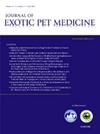Influence of environmental temperatures on chemical restraint of Nile tilapia (Oreochromis niloticus) with propofol
IF 0.6
4区 农林科学
Q4 VETERINARY SCIENCES
引用次数: 0
Abstract
Background
Fish are ectothermic animals, so the water temperature determines their body temperature and directly influences their metabolism. In the anesthetic context, this must be considered, since the action and metabolism of medications may suffer interference if the temperature is outside the zone considered optimal for the species. Therefore, due to the influence of environmental temperature on fish metabolism, this study aimed to evaluate its effect on chemical restraint of adult Nile tilapia by immersion in 0.8 mg/L propofol.
Methods
Fifty animals were randomly divided into 2 groups. In group 1 (G1), the water temperature was kept below 20° C, while in second group (G2), it was above 25° C. After a general evaluation of the animals and the measurement of baseline parameters of posture, swimming pattern, and respiratory rate (RR), the tilapias were transferred to an induction aquarium containing the anesthetic diluted in water, where they remained for 5 minutes. Subsequently, they were transferred to a towel support for 15 minutes and monitored for heart rate (HR), RR, and spontaneous movement. Following this, the animals were transferred to a recovery aquarium.
Results
Propofol maintained stable heart rates and promoted absence of spontaneous movement, as well as reduced opercular movement rates in all evaluated tilapias. Statistical differences were observed between G1 and G2 in the HR and RR, with less spontaneous movement in G1.
Conclusions and clinical relevance
In conclusion, water temperature modifies the anesthesia response in Nile tilapias, with more pronounced effects observed at lower temperatures.
环境温度对异丙酚对尼罗罗非鱼化学抑制作用的影响
鱼类是恒温动物,因此水温决定了它们的体温,并直接影响它们的新陈代谢。在麻醉环境中,必须考虑到这一点,因为如果温度超出该物种的最佳温度范围,药物的作用和代谢可能会受到干扰。因此,由于环境温度对鱼类代谢的影响,本研究旨在评价0.8 mg/L异丙酚浸泡对尼罗罗非鱼成虫的化学约束效果。方法50只动物随机分为2组。第一组(G1)水温保持在20℃以下,第二组(G2)水温保持在25℃以上。在对罗非鱼进行一般评估并测量姿势、游泳方式和呼吸频率(RR)的基线参数后,将罗非鱼转移到含有稀释麻醉水的诱导水族池中,在那里停留5分钟。随后,他们被转移到毛巾支持15分钟,并监测心率(HR), RR和自发运动。之后,这些动物被转移到一个康复水族馆。结果异丙酚维持罗非鱼心率稳定,促进自发运动缺失,并降低眼动率。G1组与G2组HR、RR有统计学差异,G1组自发性运动较少。结论及临床意义总之,水温改变尼罗罗非鱼的麻醉反应,在较低温度下观察到的效果更明显。
本文章由计算机程序翻译,如有差异,请以英文原文为准。
求助全文
约1分钟内获得全文
求助全文
来源期刊

Journal of Exotic Pet Medicine
农林科学-兽医学
CiteScore
1.20
自引率
0.00%
发文量
65
审稿时长
60 days
期刊介绍:
The Journal of Exotic Pet Medicine provides clinicians with a convenient, comprehensive, "must have" resource to enhance and elevate their expertise with exotic pet medicine. Each issue contains wide ranging peer-reviewed articles that cover many of the current and novel topics important to clinicians caring for exotic pets. Diagnostic challenges, consensus articles and selected review articles are also included to help keep veterinarians up to date on issues affecting their practice. In addition, the Journal of Exotic Pet Medicine serves as the official publication of both the Association of Exotic Mammal Veterinarians (AEMV) and the European Association of Avian Veterinarians (EAAV). The Journal of Exotic Pet Medicine is the most complete resource for practitioners who treat exotic pets.
 求助内容:
求助内容: 应助结果提醒方式:
应助结果提醒方式:


